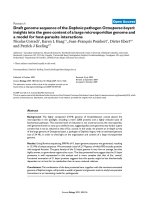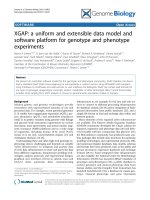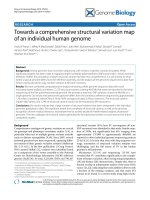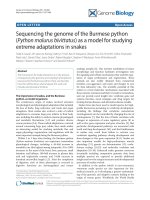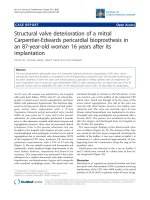Luận Án TS y học: Developing a model of client satisfaction with a rehabilitation continuum of care
Bạn đang xem bản rút gọn của tài liệu. Xem và tải ngay bản đầy đủ của tài liệu tại đây (3.07 MB, 150 trang )
University of Kentucky
UKnowledge
Theses and Dissertations--Rehabilitation Sciences
Rehabilitation Sciences
2012
DEVELOPING A MODEL OF CLIENT
SATISFACTION WITH A REHABILITATION
CONTINUUM OF CARE
Melba G. Custer
University of Kentucky,
Recommended Citation
Custer, Melba G., "DEVELOPING A MODEL OF CLIENT SATISFACTION WITH A REHABILITATION CONTINUUM OF
CARE" (2012). Theses and Dissertations--Rehabilitation Sciences. Paper 7.
/>
This Doctoral Dissertation is brought to you for free and open access by the Rehabilitation Sciences at UKnowledge. It has been accepted for inclusion
in Theses and Dissertations--Rehabilitation Sciences by an authorized administrator of UKnowledge. For more information, please contact
STUDENT AGREEMENT:
I represent that my thesis or dissertation and abstract are my original work. Proper attribution has been
given to all outside sources. I understand that I am solely responsible for obtaining any needed copyright
permissions. I have obtained and attached hereto needed written permission statements(s) from the
owner(s) of each third-party copyrighted matter to be included in my work, allowing electronic
distribution (if such use is not permitted by the fair use doctrine).
I hereby grant to The University of Kentucky and its agents the non-exclusive license to archive and make
accessible my work in whole or in part in all forms of media, now or hereafter known. I agree that the
document mentioned above may be made available immediately for worldwide access unless a
preapproved embargo applies.
I retain all other ownership rights to the copyright of my work. I also retain the right to use in future
works (such as articles or books) all or part of my work. I understand that I am free to register the
copyright to my work.
REVIEW, APPROVAL AND ACCEPTANCE
The document mentioned above has been reviewed and accepted by the student’s advisor, on behalf of
the advisory committee, and by the Director of Graduate Studies (DGS), on behalf of the program; we
verify that this is the final, approved version of the student’s dissertation including all changes required
by the advisory committee. The undersigned agree to abide by the statements above.
Melba G. Custer, Student
Dr. Ruth A. Huebner, Major Professor
Dr. Anne Olson, Director of Graduate Studies
DEVELOPING A MODEL OF CLIENT SATISFACTION
WITH A REHABILITATION CONTINUUM OF CARE
DISSERTATION
A dissertation submitted in partial fulfillment of the
requirements for the degree of Doctor of Philosophy in the
College of Health Sciences
at the University of Kentucky
By
Melba G. Custer
Lexington, Kentucky
Director: Dr. Ruth A. Huebner, Professor of Occupational Therapy
Lexington, Kentucky
Copyright © Melba G. Custer
ABSTRACT OF THE DISSERTATION
DEVELOPING A MODEL OF CLIENT SATISFACTION
WITH A REHABILITATION CONTINUUM OF CARE
Client satisfaction is an important outcome indicator because it measures multiple
domains of the quality of healthcare and rehabilitation service delivery. It is especially
important in occupational therapy because it is also client-centered. There are multiple
domains of satisfaction and findings described in previous research; however, there is no
single standard of measuring client satisfaction or any single working model describing
the relationship among variables influencing satisfaction. This research was designed to
apply a measure of satisfaction in rehabilitation and to develop a working model of
satisfaction.
This study was an exploratory and predictive study using a large existing dataset
to test a working logic model of client satisfaction, determine the best predictors of
satisfaction, and then to revise the model for future research. After developing the
Satisfaction with a Continuum of Care (SCC) in a pilot study, the SCC was completed by
1104 clients from a large Midwest rehabilitation hospital. The SCC results were paired
with administrative data with client demographics, functional status, and measures of the`
rehabilitation process. Six research questions on the predictors of satisfaction with clientcenteredness and clinical quality were answered using logistic regression.
Significant predictors of satisfaction were having a neurological disorder, total
rehabilitation hours, and admission to rehabilitation within 15 days of onset. The most
robust and consistent predictors of satisfaction in this study were aspects of functional
status as measured by the Functional Independence Measure especially improvement in
overall and self-care functioning.
The results in the study were consistent with some previous research and
inconsistent with others. The finding that improvements in functional status were highly
predictive of satisfaction supports the worth that clients place on rehabilitation results
including the self-care improvements focused on by occupational therapy.
This study was a partnership involving occupational therapy and a rehabilitation
hospital. The finding that changes in self-care function were predictive of satisfaction
was intended to isolate the effects of OT. There is a need to demonstrate outcomes and
link these to occupational therapy and other rehabilitation disciplines to continue to
identify best practices and contribute to the rehabilitation literature.
KEYWORDS: Outcomes, Predictive Modeling, Occupational Therapy, Satisfaction
Measures, Logistic Regression
Melba G. Custer
Student’s Signature
June 19, 2012
Date
DEVELOPING A MODEL OF CLIENT SATISFACTION
WITH A REHABILITATION CONTINUUM OF CARE
By
Melba G. Custer
Dr. Ruth A. Huebner
Director of Dissertation
Dr. Anne Olson
Director of Graduate Studies
June 19, 2012
ACKNOWLEDGEMENTS
Many individuals have contributed to the successful completion of this doctoral
experience. I am grateful for their efforts and commitment throughout its progress. I
would like to thank my dissertation committee members, Dr. Judy Page, Dr. Terry
Malone, Dr. Kelly Bradley, and Dr. Ruth Huebner. Their time, effort, support, and
guidance during the development and progression of this process were invaluable to me. I
would like to specifically convey my deepest feelings of gratitude to Dr. Ruth A.
Huebner, whose patience, dedication, support, and mentorship has had a profound impact
on my life, both professionally and personally.
I would also like to extend my gratitude to Dr. Susan Effgen and Dr. Carl
Mattacola, whose support and leadership have always been an encouragement to me. I
am grateful for their dedication and assistance.
In addition, this project would not have been possible without the support of many
other individuals. Alberta Cramer has provided support and encouragement throughout
this journey, a true understatement. My family in Tennessee (Margaret, Robert, Melissa,
Margaret Lyle, Aunt Frances and Aunt Gene) have been solid and ever-present as
cheerleaders. Shirley Peganoff O’Brien, Jessie Bollinger, Anne Harrison, and Kim Stacy
have all played very supportive roles in this journey. I have benefitted and appreciated
the camaraderie of Hank White, Lori Bolgla and Lyn Tindall Covert “in the trenches.”
My friends at EKU supported me greatly.
Without the support of Lisa Tudor and Cardinal Hill Rehabilitation Hospital, this
research would not have been possible. Lisa is a valued resource and friend.
A special thanks to Gordon St. Michel, the APA master.
iii
TABLE OF CONTENTS
Acknowledgements ....................................................................................................... iii
List of Tables................................................................................................................ vii
List of Figures ............................................................................................................. viii
Chapter One: Introduction .............................................................................................. 1
Background and Need ......................................................................................... 1
Statement of the Problem .................................................................................... 5
Statement of Purpose .......................................................................................... 5
Research Questions and Design ........................................................................... 5
Contribution to the Field ..................................................................................... 6
Chapter Two: Literature Review ..................................................................................... 7
Conceptual Model for Client Satisfaction Outcomes Measurement...................... 7
Conceptual Model for Outcomes Measurement ....................................... 7
Literature Review on Client Satisfaction ............................................................12
Methodology for Literature Review ........................................................12
Evolution of Client Satisfaction and Outcomes Measurement .................13
The foundations of outcomes measurement .................................13
Health care satisfaction and outcomes .........................................15
Satisfaction scale development ....................................................17
Challenges in Measurement of Patient Satisfaction .................................22
Satisfaction Studies in Rehabilitation ......................................................27
Predictive Satisfaction Studies in Rehabilitation .....................................31
Correlates of Patient Satisfaction ............................................................40
Improving Client Satisfaction .................................................................43
Methodology Literature Review .........................................................................44
Instrument and Scale Development .........................................................44
Model Building and Data Analysis Concepts ..........................................51
Functional Independence Measure ..........................................................55
Chapter Three: Methodology .........................................................................................59
Overall Research Design ....................................................................................59
Pilot Client Satisfaction Survey ..........................................................................60
Background and Design ..........................................................................60
Pilot Population ......................................................................................62
Measure ..................................................................................................63
Psychometric Analysis ...........................................................................63
Dissertation Study ..............................................................................................68
Population ..............................................................................................68
Measures ................................................................................................69
Redesign of the SCC measure: Part 2 ..........................................69
Functional Independence Measure ..............................................70
iv
Inpatient Rehabilitation Facility–Patient Assessment
Instrument .............................................................................71
Dataset ...................................................................................................73
Demographic and process variables.............................................73
Research Design ................................................................................................73
Research Question 1: How Do Client Demographic Variables
Contribute to Models of Client Satisfaction in Rehabilitation? ..........74
Research Question 2: How Does Functional Status and Self-Care
Functional Status at Admission and Discharge Contribute to
Models of Client Satisfaction in Rehabilitation? ...............................74
Research Question 3: How Does the Client’s Medical Status (e.g.,
How Sick They Are, Medical Complications) Contribute to
Models of Client Satisfaction in Rehabilitation? ...............................74
Research Question 4: How Does Variation in Rehabilitation Processes
Contribute to Models of Client Satisfaction in Rehabilitation? ..........75
Research Question 5: How Do the Client’s Gains and Discharge
Situation Relate to Models of Satisfaction in Rehabilitation? ............75
Research Question 6: How Do Occupational Therapy Services
Contribute to Models of Satisfaction in Rehabilitation? ....................75
Data Analysis Plan and Modeling Building.............................................77
Working model ...........................................................................80
Chapter Four: Results ....................................................................................................81
Psychometric Analysis of the SCC .....................................................................81
Internal Consistency ...............................................................................81
Factor Structure ......................................................................................83
Predictive Modeling ...........................................................................................87
Defining the Dependent Variable ............................................................87
Diagnostic Statistics for Logistic Regression ..........................................90
Answering the Research Questions .........................................................91
Research Question 1: How Do Client Demographic Variables
Contribute to Models .............................................................92
Research Question 2: How Does Functional Status and SelfCare Functional Status at Admission and Discharge
Contribute to Models of Client Satisfaction in
Rehabilitation? ......................................................................94
Research Question 3: How Does the Client’s Medical Status
(e.g., How Sick They Are, Medical Complications)
Contribute to Models of Client Satisfaction in
Rehabilitation? ......................................................................96
Research Question 4: How Does Variation in Rehabilitation
Processes Contribute to Models of Client Satisfaction in
Rehabilitation? ......................................................................97
Research Question 5: How Do the Client’s Gains and
Discharge Situation Relate to Models Of Satisfaction in
Rehabilitation? .................................................................... 100
v
Research Question 6: How Do Occupational Therapy Services
Contribute to Models of Satisfaction In Rehabilitation? ....... 101
Summary and Synthesis ................................................................................... 103
Chapter Five: Discussion ............................................................................................. 106
Relationship of Findings to Previous Literature ................................................ 106
Implications for Practice .................................................................................. 113
Strengths and Limitations ................................................................................. 114
Future Research ............................................................................................... 117
Conclusions ..................................................................................................... 119
Appendices
Appendix A:
Appendix B:
Appendix C:
Appendix D:
Cover Letter Quality Manager .................................................... 120
Satisfaction With Continuum Of Care ........................................ 121
Irf-Pai ......................................................................................... 123
Uk Internal Review Board Office Of Research Integrity ............. 126
References ................................................................................................................... 127
Vita ............................................................................................................................. 136
vi
LIST OF TABLES
Table 1.1, Predictive Studies of Client Satisfaction ........................................................32
Table 3.1, SCC Surveys .................................................................................................64
Table 3.2, Descriptive Statistics for Research Question 1 ...............................................74
Table 3.3, Descriptive Statistics for Research Question 2 ...............................................75
Table 3.4, Descriptive Statistics for Research Question 3 ...............................................76
Table 3.5, Descriptive Statistics for Research Question 4 ...............................................76
Table 3.6, Descriptive Statistics for Research Question 5 ...............................................77
Table 3.7, Descriptive Statistics for Research Question 6 ...............................................77
Table 4.1, Reliability Analysis for Each SCC Item or Statement ....................................82
Table 4.2, Factor Loadings for SCC Subscales ...............................................................85
Table 4.3, Client-Centeredness: Descriptive Statistics ....................................................87
Table 4.4, Quality of Clinical Service Delivery: Descriptive Statistics ...........................88
Table 4.5, Client-Centered Subscale ..............................................................................90
Table 4.6, Clinical Quality Subscale ..............................................................................90
Table 4.7, Client Demographics: Predicting Satisfaction with Client Centeredness ........93
Table 4.8, FIM and FIM self-care: Predicting Satisfaction with Client Centeredness......95
Table 4.9, FIM and FIM self-care: Predicting Satisfaction with Clinical Quality ............95
Table 4.10, Medical Status: Predicting Likelihood of Satisfaction with Client
Centeredness .........................................................................................97
Table 4.11, Rehabilitation Processes: Predicting Likelihood of Satisfaction with
Client-Centeredness...............................................................................98
Table 4.12, Rehabilitation Processes: Predicting Likelihood of Satisfaction with
Clinical Quality .....................................................................................99
Table 4.13, Discharge Status and Gains: Predicting Satisfaction with Client
Centeredness ....................................................................................... 100
Table 4.14, Discharge Status and Gains: Predicting Satisfaction with Clinical
Quality ................................................................................................ 101
Table 4.15, OT Services: Predicting Satisfaction with Client Centeredness ................. 102
Table 4.16, OT Services: Predicting Satisfaction with Clinical Quality ....................... 102
vii
LIST OF FIGURES
Figure 2.1, Dimensions of satisfaction based on previous research. ................................42
Figure 3.1, Working model: Correlates of client satisfaction. .........................................80
Figure 4.1, Predictors of satisfaction with client-centeredness. ..................................... 104
Figure 4.2, Predictors of satisfaction with clinical quality. ........................................... 105
Figure 5.1, Revised overall model of predictors of satisfaction..................................... 113
viii
CHAPTER ONE:
INTRODUCTION
Background and Need
Patient-centered or client-centered care has been an important focus in
occupational therapy for a number of years and endorsed as a fundamental principle from
the profession’s inception. Client-centered care as related to client satisfaction is now a
term frequently used in health care service delivery as an emphasis or indicator of quality
and used in accreditation. In most medical or healthcare settings, patient satisfaction has
become an important quality outcome indicator of services provided (Yellen, Davis, &
Ricard, 2002). Satisfied clients are more likely to be compliant, have higher quality of
life (QOL) and better outcomes and are more likely to return to the same provider or
institution for future care (Keith, 1998). The increased emphasis on satisfaction in the
literature may signal a new emphasis on the client as an active consumer rather than a
passive recipient of healthcare (Speight, 2005). The American Nurses Association
(1999) defined patient satisfaction as measuring patient/family opinion regarding care
received from nursing staff (ANA, 1999). From a rehabilitation perspective, Beattie,
Dowda, Turner, Michener, and Nelson (2005) defined patient satisfaction as a “construct
reflecting the overall experience of an individual receiving examination and treatment in
a given environment during a specific time period” (p. 1047).
Client satisfaction is most often measured using self-report rating scales.
Satisfaction ratings are subjective, distinct from observable events of care that can be
observed objectively and factual; it is a personal evaluation of the quality of care
received. Thus, satisfaction is a highly client-centered indicator; only the client can
perceive and report their satisfaction. Satisfaction refers generally to the match between
1
expectations and real circumstances or treatment. If the match between expectations and
service circumstances is equal, the client is generally satisfied or conversely if the service
circumstances fall below expectations, the client is dissatisfied. From a client-centered
perspective, “Optimal clients outcomes occur when clients and therapist work in
partnership throughout the therapy process and focus on the resolution of client-defined
occupational performance issues” (Law, Baptiste, & Mills, 1995, p. 253).
Occupational therapists contribute to improving overall client outcomes as part of
their everyday practice. Outcomes research is designed to describe the effectiveness of
treatment interventions (Ellenberg, 1996), demonstrate the value of health care services
(Foto, 1996), and document its relevance to the client’s needs (Kielhofner, Hammel,
Finlayson, Helfrich, & Taylor, 2004). Client satisfaction as an outcome primarily
demonstrates the relevance of the treatment, but may be related to both the effectiveness
and value of occupational therapy and the larger field of rehabilitation. Despite the
strong support for measuring client satisfaction, there has been less published research
regarding satisfaction in rehabilitation as documented by numerous authors (Elliott-Burke
& Pothast, 1997; Grisson & Dunagan, 2001; Heinemann, Bode, Cichowski, & Kan, 1997;
Keith, 1998; Mancuso et al., 2003). Currently there is no standardized way of measuring
satisfaction with rehabilitation services overall, but more work has been completed in
physical therapy to develop a few standard measures (Beattie, Dowda, Turner, Michener,
& Nelson, 2005; Goldstein, Elliott, & Guccione, 2000; Monnin & Perneger, 2002).
There are conceptual models such as The Institute of Medicine (IOM; 2001)
model that describe domains of satisfaction with the quality of healthcare, but these
domains have not been verified or translated into standardized client satisfaction
2
measures. There is a vast number of studies demonstrating the correlates or predictors of
client satisfaction, but the results are inconsistent and sometimes contradictory (Hall &
Dornan, 1988; Ottenbacher et al., 2001; Tooth et al., 2004). The relationship between the
provider and the client is frequently found as a predictor of satisfaction, but other factors
such as age, gender, marital status, type of disability, functional gain or length of stay are
inconsistently found to predict client satisfaction. Most satisfaction studies are designed
for a specific setting, a specific diagnosis or disability group, or to test the impact of a
professional group. There has been relatively limited development of logic or path
analysis models that can be tested in research.
The development of models to explain client satisfaction is in keeping with the
American Occupational Therapy Association (AOTA) research agenda identified in the
Centennial Vision (AOTA, 2007); it is critical to apply methods of computational
modeling to predict outcomes of clients in rehabilitation facilities (Brown, 2005).
Predictive modeling is supported by the Institute of Medicine (2006a) as a method to
advance knowledge and clarify theory. Through designing and testing a model of client
satisfaction, the best predictors of satisfaction in a rehabilitation setting will help
occupational therapy deliver services valued by consumers, at a critical time in the review
of health service delivery. Occupational therapy with its long history of truly living the
phrase “client-centered” as a core value can be at the forefront of changes to policy
guidelines that affect our professional stature and overall reimbursement of services.
Through implementation of the Centennial Vision (AOTA, 2007) occupational therapists
must seek to use best practices and address pertinent issues in rehabilitation.
3
This research was implemented in partnership with a community-based
rehabilitation hospital; such a partnership is crucial in linking educational needs,
research, and practice for understanding and improving functional client outcomes. A
collaborative effort between occupational therapy and a rehabilitation agency seeking to
develop outcome measures that are client-centered is also in keeping with the strategic
plan of AOTA to promote an awareness of trends in reimbursement and link research to
practice. Determining means of evaluating outcomes of OT intervention and prevention
strategies in an interdisciplinary and translational context is a critical component in any
model and recommended in the Centennial Vision.
An explanatory caveat here is intended to help the reader with language
challenges. With acceptance of The World Health Organization’s International
Classification of Functioning, Disability, and Health (ICF) (WHO, 2001) model in
healthcare, the concept patient is understood as an interchangeable term used to infer
clients. Although published works often refer to patients, clients are the inferred
population and some more recent authors refer to consumers of healthcare or
rehabilitation. Although the term patient is felt to be a pejorative term that implies a
passive recipient of services, the term client is sometimes criticized as failing to capture
the power differential in service delivery. Because of this ongoing debate, in this paper,
the term used in the published literature that was reviewed was included, but clients or
consumers of healthcare are the population of interest; these two terms are
interchangeable. The term client is used consistently in reporting the findings of this
present study.
4
Statement of the Problem
Client satisfaction is an important outcome indicator because it is a clientcentered outcome and measures multiple domains of the quality of healthcare and
rehabilitation service delivery. It is especially important in occupational therapy. There
are multiple domains of satisfaction including external and internal factors and multiple
domains of satisfaction outcome including safety, timeliness, and efficiency of service
delivery. However, there is no single standard of measuring client satisfaction nor any
single logic or working model to describe the relationship among factors and domains in
influencing satisfaction. Current research is diverse but limited by the lack of a cohesive
model that crosses disciplines, settings, and long-term rehabilitation. This research is
designed to develop and test a measurement of satisfaction in rehabilitation and to
develop a working logic model of satisfaction.
Statement of Purpose
This is an exploratory study using a large existing dataset from a communitybased rehabilitation center to test a working logic model of client satisfaction, determine
the best predictors of satisfaction, and then to revise the model for future research.
Research Questions and Design
1. How do client demographic variables contribute to models of client
satisfaction in rehabilitation?
2. How does functional status and self-care functional status at admission and
discharge contribute to models of client satisfaction in rehabilitation?
3. How does the client’s medical status (e.g., how sick they are, medical
complications) contribute to models of client satisfaction in rehabilitation?
5
4. How does the variation in rehabilitation processes contribute to models of
client satisfaction in rehabilitation?
5. How do the client’s gains and discharge situation relate to models of
satisfaction in rehabilitation?
6. How do Occupational Therapy services contribute to models of satisfaction in
rehabilitation?
The dissertation research builds on a pilot study and development of a client
satisfaction survey with a large rehabilitation hospital. The research is a nonexperimental design using an existing dataset in a descriptive and comparative study.
The dissertation study tests a working model of client satisfaction and then uses the
results to refine that model. This pilot and dissertation study was implemented in
partnership with a regional rehabilitation hospital (RRH).
Two studies are included. The first study stems from a pilot of a measure of
client satisfaction developed by the RRH and tested by the author. Based on the results
of the pilot, the satisfaction measure was redesigned; results of that pilot study are
reported here. The revised instrument was then administered to clients who were
receiving rehabilitation services for the dissertation study. The results of the dissertation
study will be used to revise a working model of client satisfaction.
Contribution to the Field
Rehabilitation is an important component of the health care process. More
individualized, it truly embodies client-centered occupational therapy service delivery.
Yet, to be effective, clients must value and desire OT services. Understanding predictive
modeling about client satisfaction can impact the profession of occupational therapy in
status and positioning to achieve the goals within the Centennial Vision (AOTA, 2007).
6
CHAPTER TWO:
LITERATURE REVIEW
In this chapter, an extensive review of the literature supporting this research is
included. The discussion is divided into three major sections. In section one, the
conceptual model for outcome measurement of client satisfaction used in this study is
explored. The second section reviews the background literature on client satisfaction.
Section two includes a review of literature defining client satisfaction, literature on
measuring client satisfaction and its broad application in healthcare, and findings from
the literature on predictors of client satisfaction specific to rehabilitation. In the third
section, the literature on model building, scale development, the Functional Independence
Measure (FIM) and statistical techniques used in the study are reviewed.
Conceptual Model for Client Satisfaction
Outcomes Measurement
Conceptual Model for Outcomes Measurement
Kohn, Corrigan, and Donaldson (2000) developed a model for improving
healthcare that was considered by the regional rehabilitation hospital, a partner in this
dissertation research, as a guide for measuring outcomes that ultimately might be used in
payment for performance systems. The rehabilitation hospital sought to measure client
outcomes in a client-centered manner using a customer satisfaction with outcomes
survey. Consequently, the IOM model and its development were used in this present
study as the conceptual framework guiding instrument development and building models
of client satisfaction. Although the IOM focuses on the broad concepts of healthcare, the
concepts apply to rehabilitation as a component of the broader healthcare delivery
system.
7
The Committee on the Quality of Health Care in America was formed in 1998
(Kohn, Corrigan, & Donaldson, 2000) by congressional mandate to develop strategies
that would result in the improvement in the quality of national healthcare over the next
decade. The initial report (Kohn et al., 2000) identified quality issues affecting patient
safety in healthcare and found for example that every year medication errors alone caused
more patient deaths than all workplace injuries combined. They estimated that adverse
drug events alone cost $2 billion annually. Even in the most prestigious hospitals, at least
2% of patients experienced a preventable adverse drug event. Kohn et al. (2000)
concluded that due to this dire state, healthcare needed to be reinvented in major ways
beginning with improvement in patient safety and the delivery of care. Needed changes
would affect physicians, hospitals, and other health care organizations that were currently
operating as silos, providing individual care without benefit of complete or
comprehensive information on a patient’s condition, medical history, services provided in
multiple other settings, and medications provided by other providers (Kohn et al., 2000).
Achieving these changes would require involvement of all the stakeholders in the
healthcare system from professionals to governing boards and should include consumers
of services to create a more client-centered service-delivery system.
In a seminal report, Crossing the Quality Chasm: A New Health System for the
21st Century (IOM, 2001), the IOM proposed six core domains for quality healthcare
improvement: safety, effectiveness, client-centeredness, timeliness, efficiency, and
equitability. Improved safety would result from avoiding injury to patients/clients while
they were seeking medical care. Effectiveness would mean consistently using evidencebased best practices at any level of care provided. Patient-centered/client-centered
8
healthcare would be responsive and respectful of client needs and values; the client’s
needs would guide decisions. Care would be provided with timeliness by reducing wait
times and delays. Efficiency would be avoiding waste of supplies, equipment, ideas, and
energy. Equitability or equitable care would be consistent quality of care without
variation from place to place or because of personal characteristics such as gender, race
or ethnicity, geographic location, or socioeconomic status.
The findings from the IOM studies (2001; Kohn et al., 2000) suggested that
healthcare systems that achieved improvements in the six areas would be globally more
client-centered that is, more responsive to meeting the needs of clients and providing
better quality care. Clients would benefit from safer care that was more responsive and
tailored to them when receiving an array of services across a coordinated continuum of
care. Improvement in the six aims would also benefit providers who would experience
increased confidence that client care was more reliable, effective, responsive, and
coordinated than before. Through adopting an emphasis on the six aims, an organization
would engage in better practices and incorporate performance and outcome measurement
to guide continual performance improvement and have data to document accountability
(IOM, 2001).
In subsequent reports, the IOM (2006a, 2007) condensed the six-aim model into
three major categories that conceptualize measurement of quality healthcare as including:
clinical quality, patient/client centeredness, and efficiency. The IOM identified clinical
quality as encompassing four of the previously identified aims of effectiveness, safety,
timeliness, and equity. Patient centeredness remained identified as an attribute of care
reflecting the informed preferences of the client. The final domain efficiency was
9
defined as a high level of quality services given resource limitations (IOM, 2007). Both
the six domain and the three domain models of health care delivery were used in
conceptualizing this research and testing the data.
The IOM (2001) noted that to date, the most frequently and effectively used
measure of quality and quality improvement relied on data about healthcare service
reimbursement. The use of payment system data had been helpful to identify overused
systems or procedures, organizations that frequently ordered high cost procedures and
geographic trends in the provision of healthcare. These findings highlighted the power of
consistent data. However, use of reimbursement data failed to consider variations in the
quality of service delivery for multiple providers. Overall, there needed to be measures
of efficient and cost effective care that were also client/patient-centered, and consistent
with better quality of clinical care.
In response to these limitations in measurement, the IOM (2006b) evaluated over
800 instruments measuring healthcare quality and found that none of the instruments or
measures incorporated all of the six aims of quality improvement. Current measures had
numerous limitations. The existing instruments focused on single episodes or single
environments of care rather than measuring across settings, levels of care, or between
departments. Existing instruments were provider-centered, asking questions about
satisfaction with the healthcare process or techniques rather than client-centered, asking
questions about experience, results, and having choice or input (IOM, 2006b). Existing
instruments often failed to address clients at the extreme ends of the healthcare
continuum (e.g., children and end of life care) and most measurement instruments were
provider-centered and provider specific with measures unique to each setting or
10
discipline. Measures needed to incorporate longitudinal changes over time. This is
especially true in rehabilitation that may progress from acute injury to acute care to
rehabilitation hospitals to rehabilitation delivered at home.
After the IOM (2006b) review, they suggested a new emphasis in measurement
that would include these limitations in the scope of measurement. Furthermore, they
anticipated that as Medicare moved towards a payment-for-performance system, ongoing
quality improvement as measured across a continuum of healthcare should be aligned
with the previously mentioned six aims (IOM, 2007).
An ideal situation would be that quality healthcare improvement and the yet to be
devised gold standard of measurement would incorporate the six aims from the IOM
(2001). The opinions and suggestions of the Institute of Medicine (IOM) have been
powerful in shaping healthcare policy and much has changed since the first report.
However, the primary mission continues to be improving the nation’s health and
healthcare system (IOM, 2001). Many of the studies and reports issued by the IOM
originated as Congressional mandates or as mandates from other governmental agencies
concerned with healthcare policy (IOM, 2001). As this process has unfolded, recent
healthcare legislation has allocated substantial funding for health care data systems to
move toward greater accountability and availability of client/patient information at the
point of service delivery.
The pilot study (see Chapter 3) and the dissertation study sought to develop, test,
and apply a client-centered measure of all six IOM aims based on client satisfaction. The
measurement design considered the limitation of current measures as described by the
IOM and sought to develop a measure that could be used in multiple settings with
11
varying client groups provided rehabilitation services over time. In the data analysis for
this study, multiple other factors suggested by the IOM (2006b) were considered. The
concept of measuring comprehensively and accurately between settings and providers
was used. The dataset paired satisfaction data with indicators to measure subgroups or
confounding variables such as age, changes in pain, changes in FIM score, and
neurological and non-neurological diagnoses. The IOM recommended that baseline
performance standards need to be established (IOM, 2007) to provide a point of origin
from which to start from when measuring provider or system wide improvement. The
present study sought to develop such a measurement system and model useful for
rehabilitation.
Literature Review on Client Satisfaction
Methodology for Literature Review
The next section covers specific literature on client satisfaction. The literature of
client satisfaction in healthcare and rehabilitation including occupational therapy is very
extensive and diverse. For example, an Internet search using the term ‘patient
satisfaction with healthcare’ on August 5, 2011 returned 24,300,000 hits. A modified
search to include ‘client satisfaction with rehabilitation’ only returned 3,540,000 hits.
Consequently, the scope of the literature review covered a sample of articles most
relevant to this dissertation study. This search was limited to articles written within the
past 10 years on satisfaction that tested the relationship between satisfaction and FIM
(Functional Independence Measure) scores, the use of one or more rehabilitation
therapies, or used logistic regression to test the predictors of satisfaction. From these
articles, historic or seminal articles frequently cited by authors were identified and
included. Articles were reviewed until a point of saturation, meaning that there was no
12
new information coming from additional articles. The literature review was divided into
sections and synthesized. Some articles were also summarized in table form. Results of
the literature review were used to develop the original working model of client
satisfaction.
Evolution of Client Satisfaction and Outcomes Measurement
In this section, the evolution of conceptualizing and measuring satisfaction is
explored. The historical background of this approach forms the foundation of
measurement. The evolution proceeds from a medical model with a physician and
nursing emphasis to the broader field including rehabilitation especially satisfaction
measures in physical therapy. From this literature, important attributes of patient
satisfaction that tie into the current research are examined and include concepts of
clinical quality, client centeredness, and efficiency.
The foundations of outcomes measurement. An early pioneer in examining the
assessment of healthcare quality, Donabedian (1966) proposed that quality was a
reflection of values and goals current in the medical care system. At that time, medical
care and the evaluation of healthcare quality were being examined at a physician-patient
level of interaction. One indicator of the quality of medical care was the restoration of
function or recovery as the most important outcome. This indicator implied an acute
focus; people returned to health or recovered. Measures of return to health, restoration of
function and avoidance of other poor outcomes (e.g., death) were concrete and easier to
quantify. As the conceptualization of outcomes evolved, other outcomes such as patient
attitudes and satisfaction provided new challenges because of their subjectivity
(Donabedian, 1980).
13



